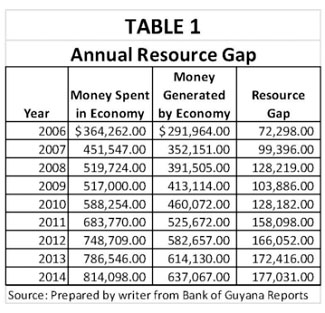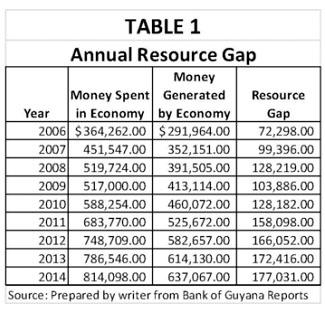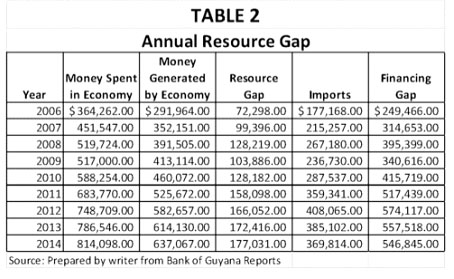Resource gap
The Bank of Guyana has been reporting for some time now on what it refers to as the resource gap. This variable is the difference between the money generated in the economy within a year from the economic activities that have been reported and the money spent to produce and consume goods and services. It is the money earned by labour and capital that is then used to buy the goods and services that were produced in Guyana. Table 1 below shows that the gap between the two variables has been steadily growing and, ignoring the sign, has always been negative. This means that Guyanese has had to find extra money continuously to gain access to the things that they have been consuming. The overall gap ‒ the amount which cannot be accounted for by any of the other official financial flows ‒ has been growing by 14 per cent each year. The question then is from where have the extra resources been coming? This article seeks to examine this issue in light of the constant concerns being expressed about money laundering and suggests that the problem persists because of a lack of cooperation among critical state institutions.
Money generated
 The money generated by the economy and the spending by Guyanese have been keeping pace with each other at 10 per cent per annum since 2007, even though that spending has shown a marked decline every year since 2011. Spending increased 16 per cent in 2011 over the 2010 period. Ever since then, it has been increasing at a decreasing rate, falling to nine per cent in 2012, five per cent in 2013 and four per cent in 2014. The income generated by the economy has also been increasing at the same pace. That is to be expected because of how the two variables are measured.
The money generated by the economy and the spending by Guyanese have been keeping pace with each other at 10 per cent per annum since 2007, even though that spending has shown a marked decline every year since 2011. Spending increased 16 per cent in 2011 over the 2010 period. Ever since then, it has been increasing at a decreasing rate, falling to nine per cent in 2012, five per cent in 2013 and four per cent in 2014. The income generated by the economy has also been increasing at the same pace. That is to be expected because of how the two variables are measured.
Spending and the money to do so contrast significantly. Not only has the resource gap grown substantially year after year, it has also has grown faster at 12 per cent per annum. Its size increases significantly when imports are accounted for in spending, as shown in Table 2 below. Imports make up nearly half of what Guyanese buy. When imports are added to the amount of money spent, the resource gap balloons to more than 70 per cent of the reported annual expenditure. The gap almost matches the money generated and captured in the national accounts.
Money laundering
The world has become seized with the issue of money laundering since the attack on the United States of America on September 11, 2001, though concerns about money laundering preceded the terrorist attacks on the USA. The initial concerns about money laundering were about the hiding of money acquired from the illicit narcotics trade and from corrupt activities. Some countries that were concerned about the uncontrolled outflow of foreign currency and had exchange controls in place also were concerned about money laundering. They wanted to discourage capital flight which tended to disrupt economic activity. The unusual outflow of capital still remains a concern among governments and international monetary institutions but they are also concerned about money laundering and its ability to finance terrorist activities.
In Guyana, the concerns about money laundering have been linked to the existence of the underground economy. As part of the global economy, Guyana also has to worry about money laundering. Professor Thomas and others have focused attention on measuring the size of the underground economy. But it is difficult to measure its size with accuracy given that activities are hidden and records are often not kept. Yet, an estimate of the hidden activities can be gotten from national accounting. National accounting captures the economic activities that are visible and that are reported. While people try to hide the receipt of the extra income that they get, they often expose its existence through their spending. It is perhaps the reason that they go after the extra income and do not report it in the first place. The spending levels of the economy seem to confirm the hypothesis that Guyanese pursue more disposal income so that they can spend it. So in a country like Guyana where people are anxious to be in the restaurants and bars until after 2 in the morning, they make it clear and unwittingly confirm that they have lots of money to spend.
Financing the gap
How does one account for the extra money seen in Table 2 that makes it possible for people to enjoy themselves the way they do in Guyana? One of the ways in which Guyanese gain access to the goods and services that they need is to borrow from the banks or their credit unions. They also obtain credit from merchants and department stores. Banks create money from the loans that they make. Borrowing has grown over the years and this could be seen from the changes in the bank balances. Bank balances change all the time because bank customers are repaying loans as new borrowers are added to the list of outstanding accounts. When customers repay loans faster than they borrow, bank balances decline and when they repay slower, the outstanding balances increase. This trend has been noticeable in the movement of the bank balances. Overall, bank balances have grown by 10 per cent per annum, but its impact on the resource gap is insignificant. It accounts for no more than five per cent of the financing gap.
A major factor for Guyanese has been remittances. The remittances form part of the transfers that come from abroad and are used in the economy to make purchases. Transfers are significant. They represent an average of $71 billion per year and have been growing at an annual rate of 10 per cent. The transfers represent about 20 per cent of the resource gap. But as substantial as the financial transfers are, they are unable to make a major dent in the gap between the income and expenditure figures. The other major source of inflow is foreign direct investment. This is money that is spent by foreign investors in the economy. Foreign investment has fluctuated over the years but has grown annually by 13 per cent and accounts for 10 per cent of the financing gap.
Despite the foreign capital inflows and the outstanding bank balances, close to half of the money spent in the economy cannot be accounted for. It is a substantial amount of money to escape the national accounts. This is a very interesting development since it raises several issues. One issue is the source of the income. It is hard to imagine that bribes alone could amount to nearly half of the money spent by Guyanese. If that were the case, it would reveal a very interesting characteristic about Guyanese consumers. They have very little knowledge about their rights and their markets. That was hardly likely and this writer believes that some other factor is at play here.
Undetected
The data in Table 2 above directs our attention to the foreign sector. Resources seem to be leaving the national economy undetected and are also returning undetected. Outward and inward smuggling activities seem to harbour the truth about the Guyana economy. The sums involved point to a massive and well organized trade. This is not your small time player hustling a quick dollar. Major businesses and public institutions were most likely involved.
Troubling issue
This observation raises a second and more troubling issue, the sincerity of the effort being made by the national agencies that should be preventing or discouraging smuggling. They are doing a lousy job. It appears as if there is no cooperation among the agencies created to tackle smuggling and money laundering. In the view of this writer, the condition of the formal Guyana economy will only worsen if smuggling is not arrested soon.












